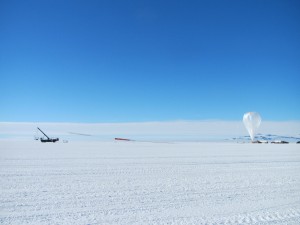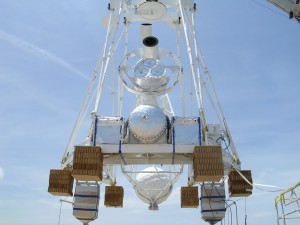
Antarctica offers a unique environment for long-duration balloon flights, which the International Focusing Optics Collaboration for micro-Crab Sensitivity (InFOCuS) mission hopes to take advantage of in 2014. Here, the Super Trans-Iron Galactic Element Recorder payload prepares for its Antarctic launch. Photo Credit: NASA
By Don Cohen
In an article on the NuSTAR launch delay in the fall 2012 issue of ASK, I wrote, “NuSTAR, the Nuclear Spectroscopic Telescope Array, contains the first focusing telescopes designed to look at high-energy X-ray radiation.” Soon after that issue was sent out, complaints began to arrive: What about the balloon missions with focusing X-ray telescopes that preceded it? Didn’t I know about HERO, the High-Energy Replicating Optics mission? Or HEFT, the High-Energy Focusing Telescope? And what about InFOCuS, the International Focusing Optics Collaboration for micro-Crab Sensitivity? Even the names of two of the three made it clear that those pre-NuSTAR missions featured focusing high-energy telescopes.

Antarctica offers a unique environment for long-duration balloon flights, which the International Focusing Optics Collaboration for micro-Crab Sensitivity (InFOCuS) mission hopes to take advantage of in 2014. Here, the Super Trans-Iron Galactic Element Recorder payload prepares for its Antarctic launch.
Photo Credit: NASA
Well, no, I didn’t know about them. I’d never heard of them. My mistake. In the online version of the NuSTAR article, we added a qualifier—the first focusing telescopes “on orbit”—to the offending sentence to make it true. I promised to correct the error in a later print issue of ASK.
Which is what I’m doing here. But when I began to look into those balloon missions, it became clear that they should have more than a brief mention in a one- or two-sentence apology. They are well worth writing about in their own right. And the way they have fostered expertise and technical advances that made NuSTAR possible and continue to contribute to new missions is an especially rich subject for ASK.
Why Balloons?

View from inside the optical bench of the HERO configuration consisting of eight co-aligned mirror modules, each module containing twelve mirror shells.
Photo Credit: NASA Marshall Space Flight Center
The drawbacks of balloon-based astronomy are obvious. The missions are very brief compared to the years-long life of orbiting telescopes, many lasting less than a full day. Although the balloons rise high enough to avoid much of the atmospheric distortion and absorption that limits Earth-based telescopes, they do not eliminate those problems entirely. And even the thin atmosphere above 125,000 feet exerts forces that make holding a steady focus on distant objects challenging.
But there are important advantages. The obvious one is cost. Launching a balloon payload costs a tiny fraction of what a rocket launch does. And, unlike an orbital mission, a balloon’s gondola and the instruments it contains can usually be recovered intact and used again.
The low cost and instrument reuse make the balloon mission especially useful for testing and improving instruments—as opposed to the orbital-science missions whose instruments need to be as close to perfect as possible before launch. That low cost and the relative frequency of missions also make them ideal opportunities for graduate students in high-energy astronomy to learn their trade—something that the more expensive but budget-limited orbital missions could not accommodate. Brian Ramsey, leader of Marshall Space Flight Center’s HERO mission, notes that balloon missions’ time scale of a few years is ideal for PhD students. Because of that relatively short span from start to finish and because balloon mission teams are much smaller than the teams responsible for orbital missions, students can be involved in every aspect of a mission.
From HEFT to NuSTAR
Graduate student experience with balloon-based high-energy astronomy brought Fiona Harrison into the field. The desire to build a more sensitive, focusing instrument eventually led to her becoming principal investigator for HEFT, a NASA-sponsored mission carried out by Caltech, Lawrence Livermore National Laboratory, Columbia University, and the Danish National Space Center. Harrison, a professor of astronomy at Caltech, says that HEFT helped develop the technology that eventually made NuSTAR possible.
Proposed in 1995, HEFT’s first flight occurred in 2005. The ten years between proposal and launch included four or five years of technology development of the instrument’s optics and detectors. A big challenge of imaging high-energy X-rays is that they can only be reflected toward a detector if they strike a mirror at a very shallow angle, grazing the surface like a stone skipping off the surface of a lake. At a steeper angle of incidence, they will penetrate the reflecting material instead. So HEFT’s mirrors are conical tubes that focus X-rays that enter almost parallel to their surface. In order to collect enough of the radiation to create a useful image, the telescope consists of several hundred reflecting surfaces nested each within the others, separated by a thin substrate.

InFOCuS heads above the clouds. At a float altitude of 128,000 feet, the balloon will inflate to 40 million cubic feet, large enough to hold several jumbo jets.
Photo Credit: NASA/Nagoya University
The teams originally used aluminum foil as the substrate but that material could not hold its shape well enough to meet the required rigorous specifications. Through trial and error, they eventually settled on a “slumped” glass substrate—extremely thin glass sheets, like those developed for flat-panel televisions, melted into the proper shape over molds (called “mandrels”). Designing and building an effective detector was also a process of trial and error. Before the first launch, several prototypes using different technologies had to be tried so the right combination could be built into the flight payload.
Without HEFT, there probably would have been no NuSTAR. For one thing, the success of the balloon mission was an incontestable proof of concept that helped convince the committee judging candidate proposals for NASA’s Explorer program that NuSTAR could perform as promised. And the HEFT team became the core of the NuSTAR team, bringing their experience and the knowledge it fostered to the orbital mission. So in addition to providing its own science results, like an X-ray image of the Crab Nebula, HEFT was a test bed and training ground for the later mission.
Not all the expertise that made NuSTAR possible comes from HEFT. At Goddard Space Flight Center, Will Zhang was working on slumped-glass substrate for mirrors for the proposed Constellation-X mission (which later merged with the European XEUS, or X-ray Evolving Universe Spectroscopy, project to become the International X-ray Observatory, or IXO). Harrison was lead of the Constellation-X team and thus knew about Zhang’s work. She determined that it had advantages over what had been done for HEFT and asked him to make glass segments for NuSTAR, which were then coated and built into mirrors by the same team that built HEFT.
From HERO to ART

Front view of the High-Energy Focusing Telescope instrument minutes before launch.
Photo Credit: HEFT Team
Marshall’s HERO mission uses a different technology for building its telescopes. Instead of the slumped-glass substrate segments used on HEFT and NuSTAR, it uses electroformed nickel replication to create nickel-cobalt shells that are then coated with a thin reflective layer of iridium. Only 1/100th of an inch thick, the shells are grown in a tank on polished aluminum mandrels. Unlike the slumped-glass substrates, which must be bonded together to make a conical whole, the nickel-cobalt shells are single conical pieces. This allows the HERO technology to provide greater angular resolution—the ability of a telescope to separately image objects at a small angular distance from one another. NuSTAR’s optics have an angular resolution of about 50 arc seconds; the angular resolution of HERO’s optics is 25 arc seconds. (One arc second is 1/3,600th of a degree of angular measurement.) HERO’s mirrors are, however, relatively heavier than glass-substrate mirrors.
HERO took the first focused hard X-ray images of any kind in 2001—images of Cygnus X-1 and the Crab Nebula. It is scheduled to fly next in the fall of 2013 to look at our sun as well as targets outside the solar system.
HERO’s superior imaging technology has been used on FOXSI, the Berkeley-based Focusing Optics X-ray Solar Imager, a sounding-rocket mission that flew in November 2012. And the Russian space program is purchasing HERO-like optics for the ART (Astronomical Roentgen Telescope) instrument aboard the Russian-led Spectrum Roentgen Gamma project, an orbital mission designed for an all-sky X-ray survey and scheduled for a 2014 launch.
The Ongoing Legacy

Brian Ramsey, lead scientist for the High-Energy Replicating Optics program, installs the mirrors that in May 2001 collected the world’s first focused high-energy X-ray images of any astronomical object. The Marshall-fabricated mirrors, a special type called “grazing incidence,” are nested cylinders with extremely smooth inner surfaces that reflect high-energy X-rays at very shallow angles.
Photo Credit: NASA Marshall Space Flight Center
Jack Tueller, principal investigator for InFOCuS, describes the “enormous technological evolution” that has characterized that mission (a collaboration between Goddard and the University of Nagoya), which launched its first balloon-borne telescope in 2001. As was true of HEFT and HERO, the InFOCuS team had to work toward the design of an effective instrument. Some of the early versions of nested reflective surfaces would “crinkle up,” says Tueller. Commenting on the trial-and-error opportunities offered by balloon missions, Tueller adds, “The risk is less than for orbital missions. If it’s not successful, you get the payload back and fly it again.”
InFOCuS continues to develop. X-Calibur, a new instrument that will detect the polarization of X-ray, will fly by 2014. And the InFOCuS team is investigating long-duration flights that would be launched from Antarctica, where wind patterns and 24-hours-a-day summer sunlight make the long flights possible. Thirty-day flights have occurred and a newly designed high-pressure balloon might stay aloft for more than one hundred days. That, notes Ramsey, could make them a low-cost competitor with orbital missions.
A new pointing system that can keep balloon-based telescopes aimed at distant objects with unprecedented accuracy should also contribute to the scientific value of future missions. The Wallops Arc Second Pointer (or WASP), developed at NASA’s Wallops Flight Facility, can steadily aim a telescope at an object or area a single arc-second wide. Ramsey hopes that WASP will be used on a future “Super-HERO” mission.
InFOCuS also currently features a rigid telescope 8 meters long, something not possible in the confined payload space of existing orbital launch vehicles. But what scientists and engineers learn from that instrument can guide future orbital missions that have a deployable folded version of an instrument of similar size.
Zhang’s continuing work on slumped-glass-based mirrors will also serve future missions. Currently, he is able to produce substrates with approximately ten times the resolution of NuSTAR’s instruments. The challenge here is whether they can be built up into a full optic and retain the good performance. The technology was expected to be used in IXO. That mission has been canceled, but the technology is ready for the future application that will come and will bring with it new discoveries.
The story of these past, present, and future missions shows how technological progress happens. Instruments become increasingly sophisticated and powerful by incorporating and improving on the achievements of their predecessors. That improvement is possible because of the openness of scientific and engineering communities to share with and learn from one another. There is competition, Zhang admits, but, he says, “We compete and cooperate.” Communication is key. “We go to the same conferences,” says Zhang. “We read and publish in the same publications; we hear things through the grapevine.” And they share the same goal: a fuller understanding of how the universe works.
Related Links
- Balloon Program Office
- High-Energy Focusing Telescope Site
- High-Energy Replicated Optics Site
More Articles by Don Cohen
- In This Issue (ASK 49)
- Interview with Alan Lindenmoyer (ASK 49)
- Interview with Lynn Cline (ASK 48)
- In This Issue (ASK 48)
- The Sky Crane Solution (ASK 47)







